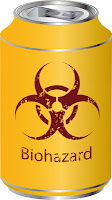Just look at Mountain Dew, for example. The hazy appearance within its very unnatural fluorescent color comes from BVO.
Patented by chemical companies as a flame retardant, and banned in food throughout Europe and Japan, BVO has been added to soft drinks for decades in North America. Now, some scientists have a renewed interest in this little-known ingredient.
Is BVO Safe?
Overall, this is probably not a safe additive. Even the U.S. Code of Federal Regulations imposes restrictions on the use of BVO in the United States. Because there are questions about its safety, an obvious restriction is to limit the amount of BVO in soft drinks. The FDA limits the use of BVO to 15 parts per million in fruit-flavored beverages.
The FDA labels BVO as an "interim food additive" which is "a food-use substance whose safety has been called into question."1 The FDA has classified only four substances as interim food additives: BVO, acrylonitrile, mannitol, and saccharin.
The European Union, however, isn't messing around with an interim labeling. They think it's dangerous and they've excluded it from the current EU-approved additives list.2
BVO Potential Health Problems
Ingesting bromine increases its concentration in your body. As it builds up, it begins to compete with iodine and causes relative iodine deficiency. The result is a condition sometimes referred to as "Brominated Thyroid." In a sense, this is a type of thyroid goiter, although the effects are more subtle than what you will see with a true iodine deficiency.3
This condition was originally seen in animal studies testing flame retardants. After the studies, the animals involved often developed low thyroid secondary to bromine leaching into their bloodstreams.
Additionally, bromine is considered a potential carcinogen and causes a number of problems such as headaches, fatigue, and possibly even heart and kidney issues. An interesting condition is called Bromoderma. These are painful skin sores that were first seen in young adult gamers who would consume large amounts of citrus-flavored drinks because of their higher caffeine content.4
Bromoderma normally occurs in people with bromine or bromide sensitivities. However, it can occur with ingestion of large amounts of bromine from certain soft-drinks.5
The FDA Says A Little BVO is Safe
As mentioned above, the FDA allows 15 parts per million of BVO in fruit-flavored beverages. This level was determined in 1977 by reports from a soda-industry group. But some scientists say that limit is based on data that is thin and several decades old.
Considering that sodas are a substantial source of calories for teenagers, scientists insist BVO needs further investigation.
What do you think? Is this another dangerous chemical that the FDA has approved in order to protect a billion-dollar industry?
Well, let's not be too hard on the FDA. We understand that they're really busy going after walnut farmers for marketing their all-natural products as heart-healthy.
References
- Fed. Reg. 25,705 (1972) (codified as amended at 21 C.F.R. pt. 180 (1996)); 37 Fed. Reg. 6207, 6208 (1972)
- http://www.food.gov.uk/safereating/additivesbranch/enumberlist#h_6
- J Clin Pathol. 1993 May; 46(5): 456 - 458.
- James, William; Berger, Timothy; Elston, Dirk (2005). Andrews' Diseases of the Skin: Clinical Dermatology. (10th ed.). Saunders. ISBN 0-7216-2921-0.
- New England Journal of Medicine 348 (19): 1932 - 34. doi:10.1056/NEJM200305083481921. PMID 12736294.




I for one look for it in my food a refuse to buy it.I used to drink mt dew every day now its been months since i drank any and wont buy it again.